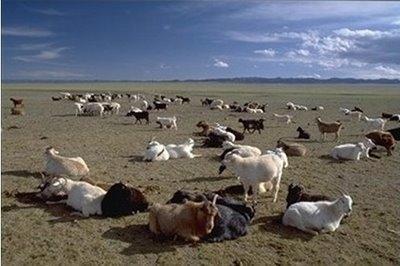 Reminiscing
Reminiscing
about how the land has changed, 40-year-old Bayanmunkh, riding slowly behind
his herd of close to 2,000 animals across Mongolia”s arid plains, told CNN,
“Life has become much harder today. Nature is not what it was 10 years
ago; there is more and more desert and less and less pastureland.” Now
Bayanmunkh has made the tough decision to move far away from the increasingly
sand-covered area his family has grazed in for generations to find a new home.
According
to U.N. Development Program estimates, 90 percent of Mongolia is fragile
dry-land; land under increasing threat from desertification. Part of the reason
for this is thought to be global warming, but in Mongolia”s case another
significant factor is the rise of the global cashmere industry.
Mongolia
is the world”s second largest producer of Kashmir goat”s wool behind only China
with 20 percent of the world market. Mongolian herders have found that cashmere
is by far the most profitable source of income available to them. They can make
MNT50,000 or USD37 a kilogram in a country where 35 percent of the population
still lives below the poverty line. Because of this, herders have been turning
more and more of their attention to increasing their goat population.
A
sharp drop in global cashmere prices last year encouraged herders like
Bayanmunkh to increase the size of their herds to compensate. Before last
winter”s harsh conditions decimated herds, goats accounted for almost half of
the country”s estimated 44 million livestock, a record high.
The
sheer number of animals grazing is putting a considerable strain on the limited
pastureland. Goats are much more voracious eaters than other livestock, and
consume the root of the grass thereby stopping it from growing altogether.
“Every year an adult goat molts about 300 to 400 grams of raw, greasy
cashmere,” says Andrei Marin, a doctoral student writing a thesis on
climate-change adaptation at the University of Bergen in Norway. “It is
therefore one of the very few constants in herders” lives and their
economy.” Marin also suggests that goats are more efficient at securing
food from low-productivity sites and are more likely to give birth to triplets
and twins, thus helping herders recover faster in the aftermath of harsh winters
like this last one.
In
2005, USAID released a report which concluded: “The herding sector [in
Mongolia] may well have surpassed the total herd size that can be sustained by
Mongolia”s pasturelands and its herds may already be causing
desertification.” With livestock numbers increasing since then, the
problem has only intensified, with previously green pastureland being swallowed
by the sand, though not all see the increasing goat population as key.
“There are, to my knowledge, no studies that show goats have a more
negative effect on pastures than other livestock,” says Marin.
Others,
however, put the blame firmly on the rising proportion of goats. “The
growing number of goats has been a major reason behind [the decline in quality
of Mongolian pastureland],” said David Sheehy, of the U.S.-based
International Center for the Advancement of Pastoral Systems, in a World Bank
report published late last year, “but there is also the general problem of
too many livestock and the added impact of climate warming.”
Following
the return of free market capitalism, the size of the country”s livestock
population has grown dramatically — almost doubling from approximately 23
million in 1993 to 44 million before this last winter. While policies to
counter pastureland degradation have been implemented it is proving tough to
limit the impact of overgrazing.
“The
threats of land degradation, and consequent desertification, are becoming a
serious obstacle to the growth of Mongolia,” says Shoko Noda, deputy
resident representative of the UNDP. “This last winter was caused by a
combination of global warming but also an unsustainable number of
animals.”
But
with demand for cashmere still high, and shop after shop in the capital of
Ulaanbaatar selling Mongolian cashmere products, it will be hard to persuade
herders to limit their involvement in the lucrative business. “It is about
moving from quantity to quality of animals, but that is very difficult,”
says Noda. “We have tried to discuss this with the government, but it
sounds as if we are trying to limit the earning potential of herders, who are
also voters.”
So
far, little has been done to persuade herders to rein in their herds, though
they themselves are seeing the impact of the overgrazing as increasing amounts
of pastureland is eaten up by the desert. “For the moment there is enough
pasture, but it is getting harder,” says Ariunzaya, as he sits beside a
small lake 20 kilometers up the road from Bayanmunkh”s slow-moving herd. His
own animals, 600 goats and 800 sheep, drink nearby. “More and more people
are coming here because the land is getting worse elsewhere,” he says.
Like
the majority of herders, Ariunzaya earns most of his money from the cashmere
trade. He sells around 150 kilograms of cashmere a year, earning about USD7,600
from this, a sizable sum in Mongolia, but he is unsure how long that can last.
“When I first arrived in this small area in 1996 there were just five
families — now there are 35. In 1995 there were about 3,000 goat and sheep,
now that number is about 15,000. I am not sure how many more it can
support.”
 3,575.44
3,575.44







